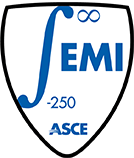Hygro-Thermal Spalling of Concrete
University of Colorado at Boulder
Problems
Concrete materials may be characterized as cementitious composites made of coarse and fine particle aggregates embedded in hydrated cement paste. It is this binder which distinguishes concrete from porous materials with a solid skeleton which is partially saturated with pore water and air. Hence, hygro-thermal loadings in form of temperature and moisture changes are mainly governed by the solid skeleton of particle inclusions and the hydrated cement paste with pores which are filled with partially interconnected pore fluids. Consequently heating and drying lead to complex interaction mechanisms among aggregates, cement stone and free pore water which take place at the meso- and micro levels of the concrete material system. One of the most challenging phenomena are spalling instabilities in concrete materials when subject to high temperatures. There are two hypotheses for their origin: (i) spalling due to restrained thermal deformations, and (ii) spalling due to vaporization of the free pore water.
Approach
Testing of 0.1 x 0.2 m concrete cylinders (f'c=50 MPa) led to a number of observations on the relative importance of these two tenets debated vigorously in the literature: (a) Ovendried concrete specimens with minimal pore pressure did not exhibit spalling under slow and rapid heating up to 500 C, (b) Saturated concrete specimens under slow heating with minimal thermal stresses did not exhibit spalling under heating up to 500 C, (c) Partially and fully saturated specimens did exhibit spalling at ~350 C surface temperature when heated rapidly at a rate of 22 K/min. However no spalling was observed under slow heating rates up to 500 C.
Findings
The experimental observations were validated by a hygrothermo-mechanical finite element study taking due account of coupling among the thermal energy and the hygral mass transport equations, and their interaction with the deformable concrete skeleton. Whereas uncoupled approaches don't capture the so-called Soret and Dufour effects of hygro-thermal transport interactions, nor the LITS effect of load-induced thermal strains and the Picket effect of load-induced shrinkage strains, the stress, temperature and internal pressure distributions obtained with the coupled poroelastoplastic finite element approach illustrate compression ring action due to rapid heating, and the formation of axial and radial tension near the heated cylinder surface responsible for the spall formations.
Impact
Spalling tendencies in concrete arise due to mismatch of the constituent properties. Whereas the residual internal stresses are of minor importance under 'normal' service conditions, spalling instabilities are driven by severe environmental conditions due to rapid heating/and cooling and concomitant phase transformations of the pore water. However, only the combination of thermal stresses and internal pore pressures leads to spalling instabilities when unrestrained concrete cylinders of low initial permeability are exposed to rapid heating.
Core competencies
- Environmental Test Chamber for hygrothermo-mechanical studies of 4x8 in specimens.
- Multi-physics modeling at two scales of observation (macro-meso levels) .
- Analytical and computational approaches for solving boundary value problems.
- In-situ spalling tests in high temperature furnace at different heating/cooling rates and different initial moisture conditions.
Current research team members:
- Pania Meshgin (Ph.D. candidate)
- Mariana Rodriguez (Ph.D. Candidate, UPC Barcelona)
- Okpin Na (Ph.D. candidate)
- Yu-Chang Liang (Ph.D. candidate)
- Nattapong Damrongwiriyanupap (Ph.D. candidate)
- Fatemah Ali (Ph.D. candidate)
Recent graduates:
- Jaesung (Ph.D. 2006), Assistant Professor, Korea.
- Lee, Keun (Ph.D. 2008), Jacobs Eng. Group Inc., Denver.
Current research collaborations:
- Mesomechanical studies of concrete materials subjected to heating and drying: Ignacio Carol (UPC Barcelona, Spain)
- Snap-back instabilities in masonry construction: Carlo Citto (Atkinson-Noland & Ass. Inc., Boulder Colorado)


